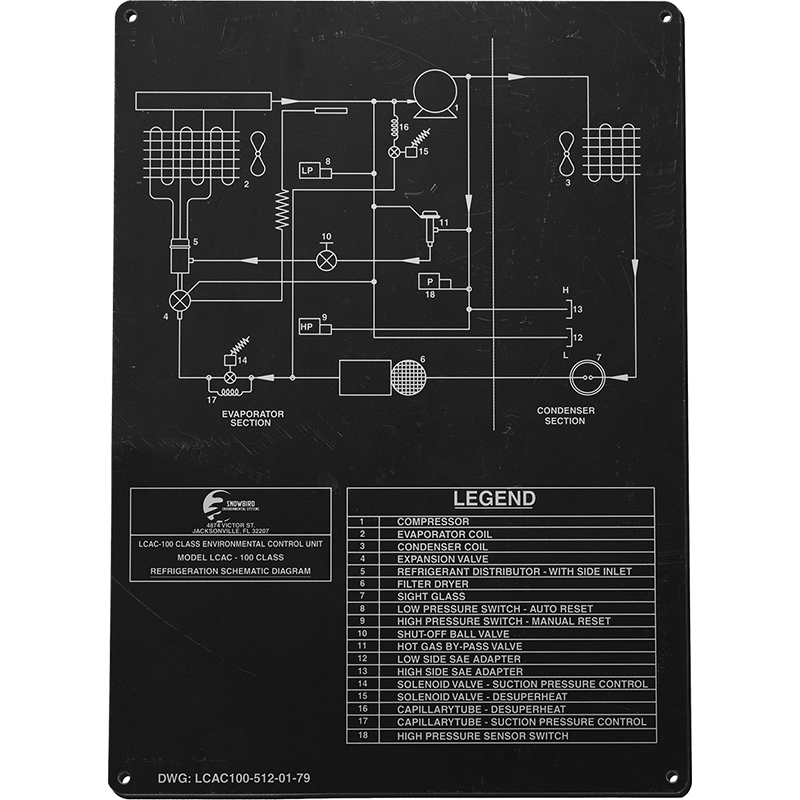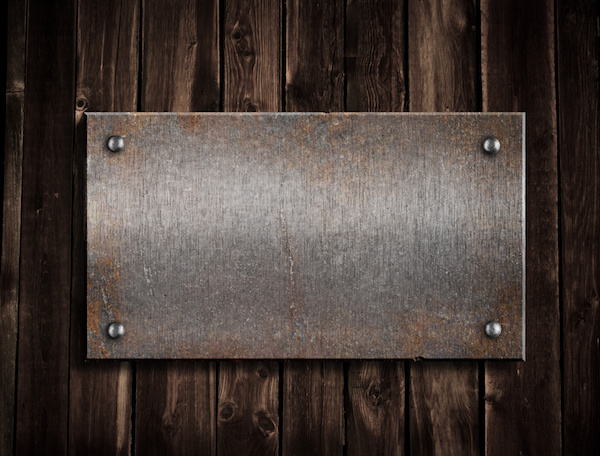First impressions matter, so having the right nameplate design can make or break an interaction with your business. But, with so many different designs for nameplates, how do you know what will work best for you?
Well, the key is to know exactly what the nameplate will be used for: Do you need it for functionality or appearance? Safety or branding? Whatever the application, choosing the perfect design for nameplates involves a couple of simple steps, and we’re here to help.
Nameplates are designed for every kind of application and environment, and there is a specific type of nameplate that will work perfectly for what you need.
In this blog, we will guide you through the process of choosing your designs for nameplates and how to determine the best materials for your application.
Let’s dive right in!
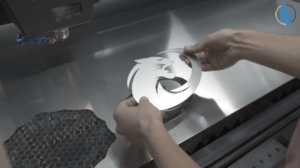
Why is Nameplate Design Important?
First impressions are everything. Would you walk into a corporate job interview wearing flip flops and a football jersey?
Think of your custom nameplate design as your first impression. This is what potential customers will see first, so you want it to make a statement!
Your nameplate design should:
- Indicate what you offer
- Be visually appealing
- Be easily readable
If you can accomplish this, you will be able to build trust with your customers before they even step through the door.
The 5 Steps to the Perfect Nameplate Design
Now let’s look at the steps to create the perfect nameplate design!
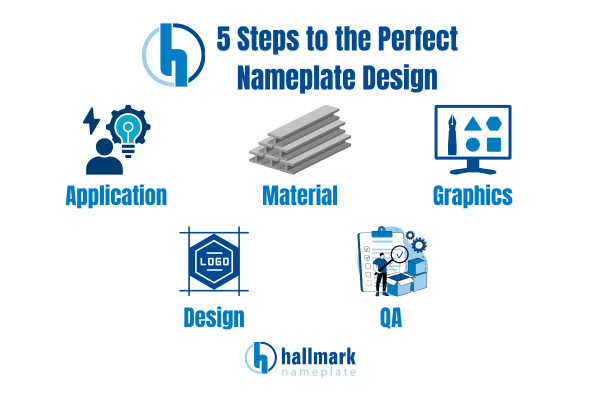
Step 1: Determine the Application
First and most importantly, finding the right nameplate design for your business depends on how it will be used. The choice of material, finish, and adhesive is contingent upon the nameplate’s environment and application. So, let’s discuss some of the different factors that may influence the materials and designs for nameplates.
Nameplate Environment
The first thing to consider is what environment the nameplate will be in. Certain materials are more resilient than others, so factors such as temperature variations, exposure to chemicals, outdoor elements, and other environmental conditions will help determine what you need.
For Indoor Use:
- Vinyl Decal Designs: Ideal for indoor spaces with minimal exposure to abrasives, vinyl decal designs offer a balance of functionality and visual appeal.
- Polycarbonate or Polyester Nameplates: In more demanding indoor applications, where durability is paramount, opt for materials like polycarbonate or polyester to ensure the longevity of your nameplate.
For Outdoor Use:
- Stainless Steel and Aluminum: These metals can withstand humidity, high temperatures, water, oils, and chemicals.
So, for outdoor applications that are exposed to weather, choose a metal nameplate that can endure the elements with resilience and reliability.
Functional Use
Another important factor to consider when designing your nameplate is its functional use. Over everything, the purpose of a nameplate is to convey information about a product, piece of equipment, or business in general. Whether providing operating instructions, safety warnings, or model details, the functional use of nameplates extends far beyond mere identification.
Here are some examples of functional uses of nameplates:
- Operating Instructions: Nameplates often include essential information on how to operate a piece of equipment or machinery. This helps users understand its functionalities and use it safely.
- Safety Warnings: Nameplates may carry important safety warnings, alerting users to potential hazards and providing guidelines to prevent accidents.
- Model and Serial Numbers: Nameplates commonly display model and serial numbers, aiding in product identification, maintenance tracking, and warranty validation.
- Technical Specifications: Nameplates can feature technical details such as voltage requirements, capacity, or load limits, providing users with critical information for proper usage.
- Compliance Information: Some industries require specific regulatory information to be displayed on products. Nameplates help meet these compliance standards, ensuring adherence to regulations.
- Brand Identification: Beyond functional details, nameplates play a key role in brand identification, displaying logos, brand names, and taglines to reinforce brand recognition.
- Material Composition: Nameplates on products like appliances may indicate the materials used in construction, helping users understand durability and maintenance requirements.
- User Instructions: For complex devices, nameplates may include concise user instructions or QR codes linking to online resources for a more detailed guide.
- Maintenance Guidelines: Providing maintenance schedules, lubrication points, or recommended service intervals, nameplates assist users in keeping equipment in optimal working condition.
As you can see, there are many different functional uses of nameplates. Once you determine the functional use, you can figure out what substrate material will work best.
Step 2: Choose the Substrate Material
Next, it’s time to decide what substrate will compose the nameplate. When it comes to selecting the substrate material for your nameplate, each option brings a unique set of characteristics. The substrate material influences not only the aesthetics but also the durability of the final product. Let’s explore the various substrate options.
Aluminum
Of all the substrate nameplates available, aluminum is hands down the most durable. Customers often favor aluminum for its versatility, allowing easy molding into diverse shapes. Its excellent durability, particularly in outdoor settings, positions it as a reliable choice for a broad spectrum of applications.
Aluminum is a great nameplate material for clients who want an attractive finish in a hard, tarnish-proof and rust-proof material. It is frequently used for outside applications, but it can also be used inside. Its most common use is for equipment asset tags.
- Anodized Aluminum: Anodized aluminum adds an extra layer of durability, forming a protective shield against abrasion and corrosion. This feature makes it an ideal choice for applications demanding heightened resistance in challenging conditions. It can also be color-customized to match your brand identity.
- Metalphoto® Aluminum: Recognized as the most durable metal, Metalphoto® stands out for its longevity and photographic resolution. A preferred material in industrial and military engineering for over five decades, it meets stringent government, industrial, and military specifications, including MIL-STD-30.
Stainless Steel
Recognized for its density and exceptional scratch resistance, stainless steel takes the lead in the food industry. Its antimicrobial qualities further elevate its status as the gold standard, ensuring both durability and hygiene.
Stainless steel has 3 main classifications:
- Austenitic: Face-centered cubic (FCC) crystal structure, non-magnetic, corrosion-resistant.
- Ferritic: Contains chromium, magnetic, and typically used for nonstructural applications.
- Martensitic: Contains chromium, strengthened through heat treatments, may be magnetic.
Austenitic stainless steel carries 200 and 300 series numbers, while ferritic and martensitic classes belong in the 400 series.
Brass
An attractive and affordable alternative to classic gold nameplates, brass nameplates are constructed from a copper and zinc metal alloy, which makes them resistant to corrosion. It’s similar to bronze, a copper and tin alloy, although brass usually appears more gold, while bronze has a reddish tone.
Brass is sometimes chosen for nameplates because of its decorative quality and rich, golden color. Common uses of brass nameplates include plumbing and electrical applications, and for environments where sparks are a concern, as it’s a non-sparking material.
Polyester
Polyester, with its high tensile strength, finds practical application as a nameplate for product and packaging identification, combining durability with functional visibility. It is UV resistant, non-yellowing, electrical resistant, water, chemical, and abrasion resistant, and won’t fade in the sun.
Common uses for polyester nameplates include asset tags, product identification, electronics, packaging, magnetic media, imaging, and graphing. Also, it can be used to create protective overlays for outdoor applications and high-traffic areas.
Polycarbonate
Chosen for its rigidity and superior durability compared to polyester, polycarbonate serves as a robust plastic substrate. Ideal for applications demanding strong resistance to abrasion and heat, it ensures longevity in challenging environments.
Polycarbonate labels provide exceptional optical clarity, color reproduction, depth effect, graphic design flexibility, printability, and dimensional stability. A common use of polycarbonate nameplates is as asset tags, in addition to other types of nameplates and labels. It is the perfect choice for highly detailed printing.
Vinyl
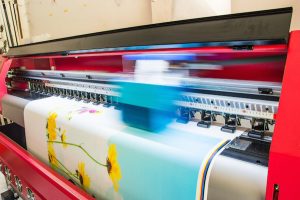
Renowned for its versatility and vibrant appearance, vinyl is a popular substrate material for nameplates. Its adaptability allows for intricate designs and color variations, making it an ideal choice for applications where visual aesthetics play a crucial role.
While it may not match the durability of metals, vinyl nameplates excel in indoor settings, providing an affordable and visually appealing solution for various identification needs.
Step 3: Create a Graphic
Once you’ve decided on the material that best fits your nameplate’s application, it’s time to solidify the process by deciding what you want on the nameplate. Whether you want to include text, logos, graphics, QR codes, or barcodes, the design for the nameplate you choose will determine the printing process.
Here are a few of the different nameplate processes.
Screen Printing
- Cost-effective method for placing graphics and colored logos onto metal surfaces.
- Utilizes a mesh screen and an applicator to apply ink or epoxy.
- Employs spot colors for line art, logos, and text with clean edges and color control.
- May require a final coating for added durability, especially in chemical-exposed environments.
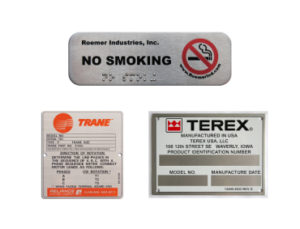
Digital Printing
- Ideal for unique colors, gradient colors, and halftones on nameplates.
- Offers extensive customization opportunities, including fabrication styles like rounded corners, holes, and adhesives.
- Well-suited for various fabrication styles, providing flexibility in design.
- Digital printing allows for unique data such as QR Codes, Barcodes, and Portable Data Files.
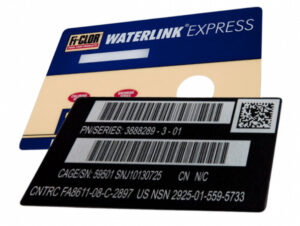
Engraving
- Suitable for both metal and plastic nameplates.
- Involves a rotating tool cutting into the material at the desired depth following a computer-generated design.
- Creates a permanent design with minimal wear, making it a durable option.
- Particularly effective for designs that need longevity and resistance to wear.
Embossing

- Well-suited for metal nameplates.
- Raises the surface of the material to create a three-dimensional design.
- Adds a tactile and visual element to the nameplate, enhancing its aesthetic appeal.
- Ideal for applications where a textured or raised design is desired for branding and identification.
Etching
- Effective for both metal and plastic nameplates.
- Involves chemically or mechanically removing material to create intricate designs.
- Adds subtle elegance to the design, suitable for applications requiring sophistication.
- Creates a durable design with a refined look, making it ideal for various industries.
Step 4: Outline Nameplate Design Specifications

Now, the nameplate design specifications must be established before the nameplate is created. You can customize the size, shape, thickness, and dimensions of your nameplate at this stage. Budget considerations may affect your decision, so keep that in mind when outlining your design specifications.
When looking into the specifications set, create a checklist to ensure that each part of the custom nameplate lives up to your expectations:
- Dimensions
- Materials
- Layout
- Spelling
- Adhesion Type
- Color
You don’t want to start the project only to realize the nameplate was supposed to be 12 inches instead of 12 feet, or realize that it should say Industries instead of Industrial.
Step 5: Final Production and Quality Assurance
Finally, the last step is to make your nameplate design a reality! This crucial step involves leveraging cutting-edge technology and skilled craftsmanship to bring your custom nameplate to life with precision and reliability. Our state-of-the-art production process ensures that every aspect of the designs for nameplates, from dimensions to materials, meets the highest standards.
Additionally, quality assurance measures guarantee that the custom nameplate you receive not only reflects your brand vision but also withstands the test of time in diverse environments.
Create a Beautifully Designed Custom Nameplate With Hallmark Nameplate
At Hallmark Nameplate, our commitment to excellence extends from the initial concept to the final production. Our streamlined process involves creating a meticulous prototype of your design for the nameplate before full-scale production begins.
- Efficient Production: Our streamlined production process ensures timely delivery without compromising on quality.
- Quality Assurance: Rigorous quality checks are conducted to guarantee that each custom nameplate meets our stringent standards.
- Material Excellence: We employ top-notch materials to enhance durability and longevity, meeting the diverse demands of different industries.
When you choose us, we ensure a custom nameplate that reflects your brand vision and exceeds expectations in terms of performance and aesthetic appeal. Trust us to deliver a finished product that makes a lasting impression.
Contact us today for a FREE quote or visit our website to learn more about our services.


